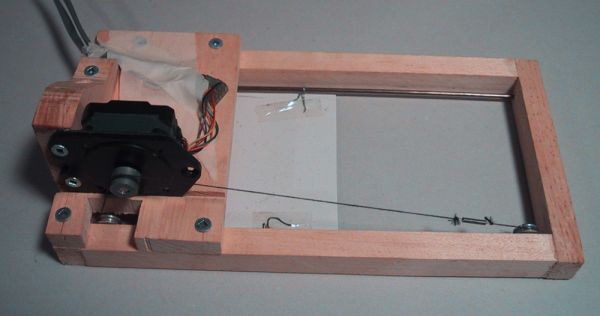
I bought my first serious camera (an Olympus OM-10) in September 1990, and for a few years after that was fanatically into photography. By December 1990 I had a darkroom outfit, but I could only use it when I was at home at my parents' on summer or Christmas holidays. It wasn't until 1992, when I moved to where I still live in 2003, that I could set up a permanent darkroom (also known as a laundry room).
Naturally, I wanted to computerize the darkroom operations, so I built this gadget:
It was connected to an improvised driver circuit, which plugged into the "user port" on the back of a Commodore 64. The stepper motor (scroungers will recognize it as the head actuator from an 80s vintage hard disk) moves the cardboard slider back and forth under computer control. The "rails" are coat hanger wire.
To use it, the gadget was placed on top of a small scrap of photo paper, and the "make test strip" option selected on the computer. The computer would turn on the enlarger light, then move the slider at preset intervals to expose a test strip say, for 10, 12, 15, 20, 30 seconds, then turn the enlarger light off again. The scrap would then be developed, and the best exposure chosen. The computer also acted as the timer for making the actual print.
The whole setup can be seen in the improvised darkroom in this photo taken at the time. The "well" behind the computer contained a black-and-white monitor turned to a barely legible (in the dark) level of brightness.
The high-tech solution isn't always the best one. I soon went back to the old-fashioned turn-the-knob darkroom timer. With more practice, I didn't have to make so many stepped test strips anyway, I just took a guess, exposed one test scrap, and then made the print with the appropriate guessed offset.
I last used the darkroom setup in 1996. I probably never will again, now that photography has (for me) gone irrevocably digital.